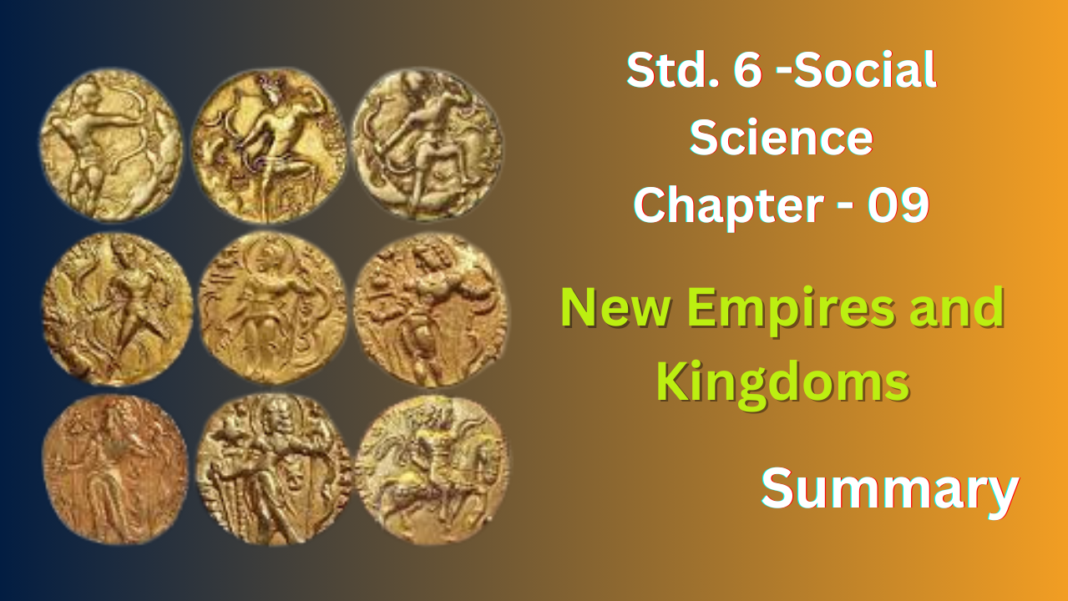NCERT Solutions for class 6 History Chapter 9
This chapter explores the rise of new empires and kingdoms in India after the decline of the Mauryan Empire. Here are the key points:
From Kingdom to Empire:
- The chapter might begin with the story of Chandragupta Maurya and the rise of the powerful Mauryan Empire. However, the focus quickly shifts to the period following its decline.
New Political Landscape:
- After the Mauryas, several smaller kingdoms and empires emerged across India. The chapter introduces some prominent ones like the Gupta Empire in the north, the Chalukyas and Pallavas in the Deccan region, and the Satavahanas (whose power had diminished but still held some influence).
Prashasti:
- The concept of Prashasti is introduced. These were inscriptions or poems praising the achievements of rulers. Studying Prashastis can tell us about the rulers’ conquests, administration, and values. (Examples might include the Allahabad Pillar inscription of Samudragupta)
Harshavardhana:
- Harshavardhana is another important figure from this period. He ruled a kingdom in north India and was known for his military prowess, literary pursuits, and efforts to unite different regions. The biography Harshacharita by Banabhatta provides valuable information about his reign.
Administration:
- The chapter might briefly touch upon the administrative systems of these kingdoms. Officials managed different regions, collected taxes, and maintained order.
Culture and Achievements:
- This period witnessed significant advancements in art, literature, science, and mathematics. The chapter might mention famous universities like Nalanda and Taxila, or architectural marvels like the Ajanta and Ellora caves.
Decline and Legacy:
- The chapter might conclude by mentioning the eventual decline of these empires and kingdoms due to various factors like internal conflicts or invasions. However, it emphasizes their lasting legacy in shaping Indian history, culture, and administration.
NCERT Solutions for class 6 History Chapter 9
Let’s recall
1. State whether true or false:
(a) Harishena composed a prashasti in praise of Gautamiputra Shri Satakarni.
(b) The rulers of Aryavarta brought tribute for Samudragupta.
(c) There were twelve rulers in Dakshinapatha.
(d) Taxila and Madurai were important centres under the control of the Gupta rulers.
(e) Aihole was the capital of the Pallavas.
(f)Local assemblies functioned for several centuries in south India.
Ans : (a) False
(b) True
(c) False
(d) True
(e) False
(f) True
2. Mention three author who wrote about Harshavardhana.
Ans: Three authors who wrote about Harshavardhana include:
- Banabhatta: He is considered the most prominent author, and his work Harshacharita is a biography of Harshavardhana. It provides valuable insights into his life, achievements, and personality.
- Xuanzang: A Chinese Buddhist monk and scholar, Xuanzang visited India during Harsha’s reign. He documented his travels in the Great Tang Records on the Western Regions, which includes information about Harsha and his court.
- Ravikirti: He was the court poet of Pulakeshin II, a Chalukya ruler who was a contemporary of Harshavardhana. Ravikirti’s writings might mention Harsha, particularly inscriptions like the Aihole inscription, which briefly describes a conflict between the two rulers.
3. What changes you find in the army at this time?
Ans : Witnessed significant changes in warfare and military structures compared to the Mauryan Empire. Here are some key points to consider:
Increased Use of Cavalry:
- The prominence of cavalry (soldiers on horseback) increased during this period. Horses provided greater mobility and striking power on the battlefield compared to relying solely on infantry.
Emergence of Feudalism:
- The rise of feudalism impacted armies. Landowners might have provided mounted warriors in exchange for land grants or other favors from the king. This system, while providing a source of soldiers, could also lead to complex loyalties and potential challenges to central authority.
Specialized Roles and Weaponry:
- Armies might have become more specialized, with soldiers trained for specific roles like archery, swordsmanship, or operating siege engines. Weaponry might have evolved to include new types of bows, swords, and armor.
Elephants Continued to Play a Role:
- Though cavalry gained importance, elephants still played a role in warfare, particularly for shock tactics and carrying archers or other soldiers into battle.
Fortification Techniques Improved:
- Kingdoms invested in building stronger forts and improving fortification techniques to withstand sieges and protect their territories.
4. What were the new administrative arrangements during this period?
Ans : some new administrative arrangements that emerged during this period compared to the Mauryan Empire. Here are some key points to consider:
Hereditary Positions:
- One change might be the practice of making some important administrative positions hereditary. This means sons inherited their fathers’ positions, creating a sense of continuity and potentially leading to families accumulating power within the administration.
Multiple Roles for Officials:
- Another feature might be that some officials held multiple roles simultaneously. This could have been due to a smaller administrative pool or a desire to concentrate power in the hands of trusted individuals. An example could be someone serving as a military commander and a regional governor.
Greater Role for Local Authorities:
- In some regions, there might have been a greater role for local assemblies or powerful families in managing local affairs. This could be a way to maintain control over vast territories by giving some autonomy to local leaders who understood the specific needs of their regions.
Let’s Discuss
5. What do you think Arvind would have to do if he was acting as Samudragupta?
Ans: If Arvind were acting as Samudragupta, he would have his hands full! Here are some of the things he might have to do:
Military Campaigns:
- Lead a vast army on various military campaigns to expand the Gupta Empire’s territory. This could involve battles against rival kingdoms in northern India, subjugating smaller states, and potentially pushing south towards the Deccan.
Administration:
- Oversee the efficient administration of the growing empire. This might involve appointing governors, collecting taxes, maintaining law and order, and ensuring smooth trade within the empire.
Diplomacy:
- Engage in diplomacy with other kingdoms. This could include forging alliances, negotiating trade deals, or issuing warnings to potential rivals. Samudragupta’s approach varied depending on the kingdom – some were directly conquered, some offered tribute, and some were left alone.
Religious Patronage:
- Uphold and promote Hinduism, the dominant religion of the Gupta Empire. Samudragupta might sponsor the construction of temples, support scholars and artists, and participate in religious ceremonies.
Performance of Rituals:
- As a Hindu king, Arvind might be expected to perform various rituals and sacrifices to appease the gods and ensure prosperity for the empire.
Maintaining Internal Stability:
- Manage internal affairs and ensure stability within the empire. This could involve resolving disputes among different factions, promoting social harmony, and dealing with potential rebellions.
Patronage of Arts and Sciences:
- The Gupta period is known for its flourishing art and literature. Samudragupta, himself a poet and musician, might encourage scholars, artists, and architects, potentially commissioning works of art and literature.
Living Up to the Legacy:
- Arvind would likely feel pressure to live up to Samudragupta’s legacy. Samudragupta was a skilled military leader, a capable administrator, and a patron of the arts. Fulfilling these expectations and maintaining the empire’s power would be a constant challenge.
6. Do you think ordinary people would have read and understood the prashastis? Give reasons for your answer.
Ans : No, ordinary people likely wouldn’t have read and understood the prashastis for several reasons:
- Language Barrier: Prashastis were typically written in Sanskrit, a complex and learned language not spoken by the common people. Ordinary people might have spoken regional languages like Prakrit, Tamil, or Telugu.
- Limited Literacy: Literacy rates were likely low among the general population in ancient India. Most people would have been involved in agriculture, crafts, or other manual labor and wouldn’t have received formal education.
- Location of Prashastis: Prashastis were often inscribed on pillars, caves, or temple walls. These locations, while public spaces, wouldn’t have been readily accessible to everyone, especially those living in rural areas.
- Content and Style: Prashastis often used elaborate language and literary devices that might have been difficult for ordinary people to comprehend. They focused on praising the king’s achievements and victories, not everyday life.
NCERT Solutions for class 6 History Chapter 9
FAQ’s
What topics are covered in Class 6 History Chapter 9: “New Empires and Kingdoms”?
Class 6 History Chapter 9 explores the emergence and expansion of new empires and kingdoms in ancient times, covering topics such as conquests, dynastic changes, and cultural exchanges.
How can NCERT solutions for Class 6 History Chapter 9 help in understanding new empires and kingdoms?
NCERT solutions offer detailed explanations and analyses of historical events and concepts related to the rise and fall of empires and kingdoms, helping students grasp the complexities of political, social, and cultural developments in ancient civilizations.
Where can I find NCERT solutions for Class 6 History Chapter 9?
NCERT solutions for Class 6 History Chapter 9 can be found online or in study materials provided by educational platforms or institutes specializing in academic resources.
When should I refer to NCERT solutions for Class 6 History Chapter 9?
They can be used alongside regular study or as a revision tool before assessments to enhance understanding of the dynamics of ancient empires and kingdoms.
What specific historical examples are discussed in Class 6 History Chapter 9 regarding new empires and kingdoms?
Class 6 History Chapter 9 discusses various examples of ancient empires and kingdoms, such as the Mauryan Empire in India and the Roman Empire, offering insights into the factors and processes involved in their rise and fall.









